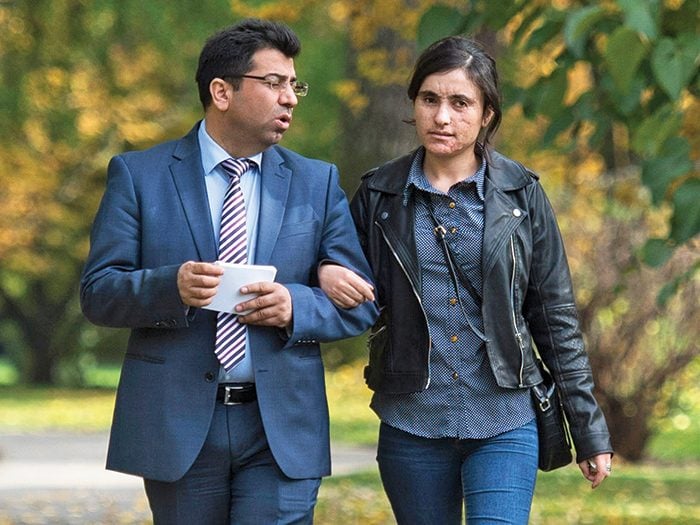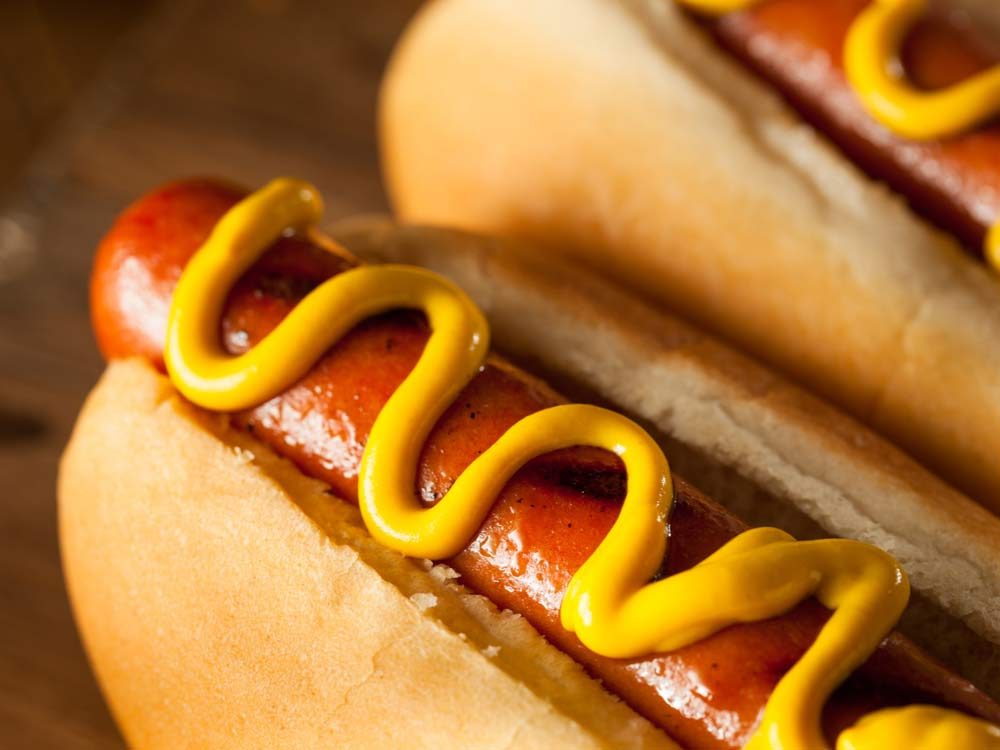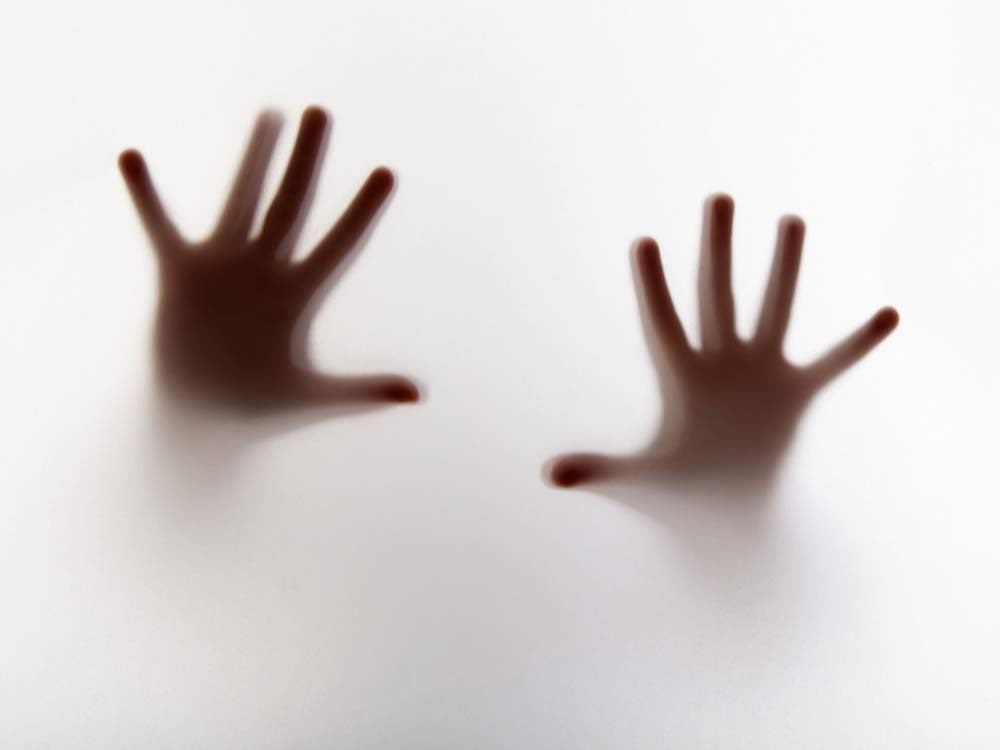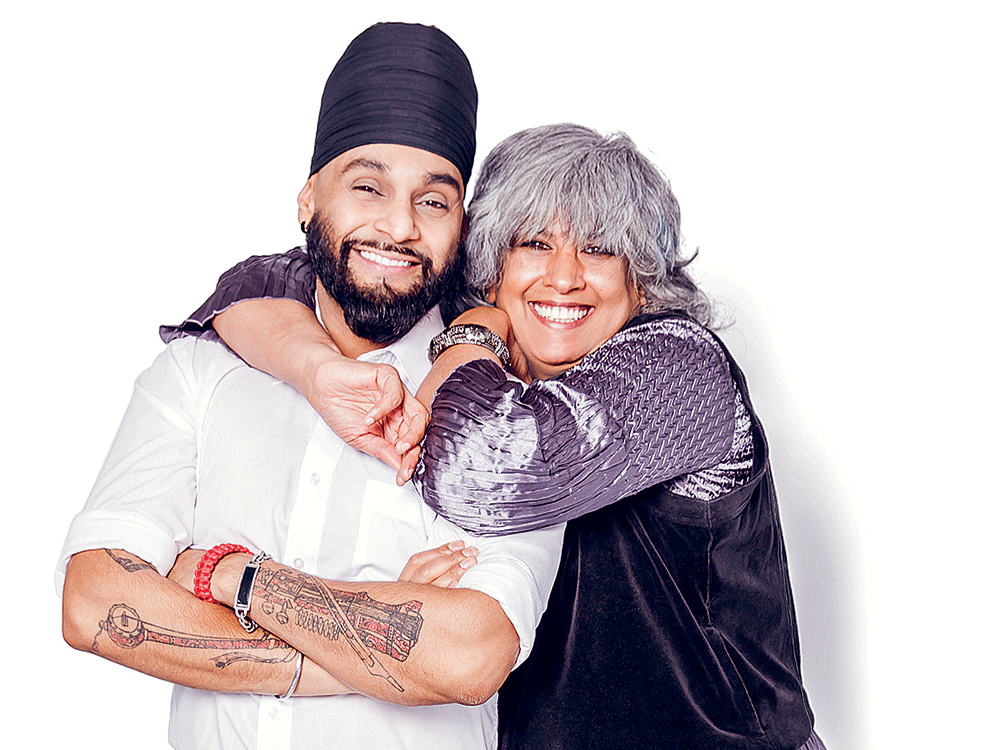
Help from on high
Technology At times of natural disaster and conflict, it can often be hard to get aid quickly to where it’s needed. But 70-year-old engineer Nigel Gifford (pictured right), from Somerset, England, has come up with a novel way of getting round—or rather over—the problem.
Gifford’s unmanned air vehicle, called Pouncer, can be loaded with 50kg of rations, dropped from a plane and then fly independently for up to 40km to its destination. The Pouncer’s shell can also be used to provide shelter, and its frame can be burnt to cook food. And a future version is planned that will be made of edible material.
Gifford has a good track record as an inventor, having already come up with a high-altitude drone that can beam internet or mobile phone connectivity to people on the ground. That was bought by Facebook for £16m. He’s now itching to get his new project out in the field. “The key is getting the Pouncer used for humanitarian aid,” he says. “If this existed now, it would be saving lives in Syria.”
How to be part of history
Heritage Ever fancied owning your own Italian castle? Or how about a monastery? Well, now you can have one absolutely free, because the Italian government is giving away more than 100 historic buildings.
The catch is you must commit to transforming your new property into a tourist facility, such as a hotel, restaurant or spa. The idea is part of a plan to take the strain from Italy’s most overcrowded attractions and promote lesser-known areas.
“The project will promote the development of the slow tourism sector,” says Roberto Reggi of the State Property Agency. “The goal is for private and public buildings that are no longer used to be transformed into facilities for pilgrims, hikers, tourists and cyclists.”
Ocean Cleanup progress
Environment There’s more news on Boyan Slat, Reader’s Digest’s European of the Year. The young Dutchman, who’s invented a technology to clear the oceans of millions of tons of floating plastic rubbish, has announced that his Ocean Cleanup Foundation will start operations by next May.
Thanks to an improved design, he believes it can clear half the so-called Great Pacific Garbage Patch in five years. “The cleanup of the world’s oceans is just around the corner,” he claims.

Rescuing the yazidis
Heroes In the summer of 2014, ISIS soldiers in northern Iraq massacred thousands of men from the minority Yazidi community, and took thousands more Yazidi women and children as sex slaves.
Dr. Mirza Dinnayi, a Yazidi himself, who had moved to Germany in 1994 to escape persecution, embarked on a perilous mission to help hundreds of them to escape. He found an ally in the state of Baden-Württemberg which promised them a home, as well as care and therapy after their arrival.
Dinnayi returned to Iraq, risking the threat of physical violence, to track down, vet and arrange transport for survivors. Worst of all, however, was hearing their tales of rape and torture: “When I remember their stories, I think, ‘How could such things happen in the 21st century?’”
Thanks to Dinnayi’s initiative, 1,100 Yazidis have now begun new lives in Germany.
Sources: Technology: Wired, 15.02.17. Heritage: The Local (Italy), 15.05.17. Environment: Ocean Cleanup, 11.05.17. Heroes: The Daily Beast, 15.05.17

How to braise a whole chicken in your slow cooker
Slow cookers can remove paint, make candles, and make Playdough. And make food, as it turns out! But the slow-cooking titan of many a kitchen counter can tackle much more than just jambalaya, ribs, and pot roast. As it turns out, the slow cooker is the perfect place to braise your bird.
As it goes with slow-cooker recipes, patience is a virtue. You can grab a roaster and toss it in the oven, and an hour or so later you’re good to go. A chicken in the crock-pot will be cooked in four to eight times the duration. But the results are hard to deny. (Find some other amazing chicken recipes!)
The instructions are pretty simple. Season the bird as you wish, and don’t sweat the risk of charred seasoning. Make sure the crockpot is the proper size; usually five-quarts does the trick. Now, place in the bottom of the crock pot five or six crushed up balls of aluminum (or a plethora of root vegetables), replace the lid and set the cooker on low for seven or eight hours, or on high for around four hours.
When it comes to testing the temperature, feel free to slice right into the chicken breast. This may be blasphemy in the oven, but in the slow cooker, you don’t run the risk of having your poultry dry out.
The end product is a perfectly moist chicken, ready to go for several meals. There’s no wasting time, and no hassle heating up the whole kitchen with the oven.
Make sure to check out 7 Cooking Mistakes Everybody Makes (and How to Fix Them).

Here’s the one condiment you should never put on your hot dog
Don’t bring wine to a hot dog party. Don’t serve sausages on fine china. Never let a fork or knife touch your hot dog and always leave an empty plate when you’re done. To leave any bits of bun behind would be an insult to the chef, to the hot dog, and to the United States of America—the land where franks are king.
These rules, among many others, appear on the “hot dog etiquette” page of the National Hot Dog and Sausage Council website. The Council—a no-joke, non-partisan organization established by the American Meat Institute in 1994—mainly serves as a resource for nutrition, quality, and safety information about America’s favourite tube of meat. But with etiquette standards like those listed above, the Council takes on a cultural mission as well: to maintain “the unpretentious nature of hot dogs,” a food that has come to symbolize the simplest pleasures of boardwalks, barbecues, and all-American, bun-in-the-sun summer leisure.
The simple purity of hot dogs is something we can all agree on. However, one edict on the Council’s site might make your buns quiver in fury—especially if you’re a fan of the reddest condiment. Per the Council’s orders, it is absolutely unacceptable to “use ketchup on your hot dog after the age of 18.”
That’s right: If you’re an adult, no ketchup for you. (Mustard, relish, onions, cheese and chili are acceptable.)
It’s an age-old hot dog debate, hotly contested in the Frank Belt of downtown Chicago and other legacy beef towns. The rationale? “Ketchup smothers the flavour of the hot dog because ketchup makers add sugar to their products,” writes the Straight Dope, paraphrasing BBQ guru Mel Plotsky, former sales manager for the David Berg hot dog company in Chicago. “That takes the edge off the highly acidic tomatoes, but it takes the edge off everything else, too. Which is exactly why a lot of parents like it.”
If you have young kids in your life, you’ve probably witnessed the earliest signs of ketchup obsession firsthand. (I’ll never forget the day I saw my two-year-old nephew ignore a perfectly good plate of chicken nuggets as he forklifted gobs of raw ketchup into his mouth with his bare hands.) Ketchup is sugar paste that swallows up anything it touches, including sumptuous beef franks. Simply put: ketchup is kid’s stuff.
“We all have to grow up sometime.” says Janet Riley, the self-proclaimed “Queen of Wien” and former Council President, in a helpful etiquette video on the Council website. “Besides, legend has it that within the city limits of Chicago you can be arrested for such an offense.” (We couldn’t find any proof of this second claim, but we did uncover this head-scratching list of the most bizarre laws in Canada.)
Should you be arrested for sullying a hot dog with sugar sauce? That’s up to the United States. Should you be ashamed of yourself for doing so? That, friends, is between you, your conscience, and the National Hot Dog and Sausage Council.
Here are 27 Foods You Should Never Ever Buy Again.

A few months ago, a man climbed through my window and stood over my bed, staring down at me. Before that a huge snake-like creature slithered out from my closet and onto my bedcovers. And once I stumbled across a dead body stretched out on my floor.
I suffer from hypnopompic hallucinations, which means I see things when I’m waking. I sit up in bed, eyes open, and watch a CGI movie my brain is projecting onto the world. The condition is caused by a broken neural off-switch. When we dream our body paralyzes our muscles to prevent us from leaping out of bed to act out the mental images we’re seeing. In my case, however, the paralysis shuts off and I bolt awake, still dreaming.
According to Dr. Raymond Gottschalk, medical director of the Sleep Disorders Clinic in Hamilton, up to 15 per cent of Canadian adults suffer from a category of sleep disorder known as parasomnia. “The brain has a hundred billion neurons,” says Gottschalk, “so it’s not surprising a crossed wire now and again causes a glitch with our sleep.”
My hallucinations started in 2008. They involved men, often lurking in the corner, sometimes lunging at me. But I’ve also seen large spiders, monstrous bugs and fearsome bats. With every apparition I would run from the bedroom, screaming. My boyfriend would later find me curled up in a ball on the kitchen floor, covered in sweat, hoarse-voiced, heart pounding. At work I was exhausted and shaky, on the constant verge of tears, unable to concentrate. At night I had to be coaxed to bed. And the more scared I was of going to sleep, the more I hallucinated. A year later it was happening almost every night.
In the spring of 2010 I got a referral to a sleep lab where I explained my complaint to doctor after doctor. But with night terrors being one of the most misdiagnosed sleep disorders (sometimes it’s confused with restless leg syndrome or simple nightmares), it took almost a year before they could even name my condition. And even then, not knowing how to treat it, the doctors—who were aware I was also prone to moderate sleep apnea—recommended I try wearing a special mask that helps sufferers breathe properly through the night by forcing air down their nose. It just made things worse; waking up in a mask only aggravated my panic when I hallucinated.
I did everything you’re supposed to do—practice yoga, cut out caffeine, avoid alcohol. But the hallucinations remained. On my last visit to the sleep lab the doctor said my only remaining option was dream-suppressing drugs. Anxious about taking medication, I declined the sedatives. The doctor sent me on my way with one further suggestion: Get more sleep.
I went to my family physician, who gave me the name of a cognitive-behavioural clinic. I’d never been to therapy before, and with no dark past or traumatic childhood episodes haunting me, I didn’t think I’d have anything to talk about. But rather than look for medical reasons for my sleep problems, my therapist saw the hallucinations as by-products of a wild imagination and an overly active fight-or-flight reflex—kind of like I was having panic attacks while asleep. We focused on my coping techniques during the day so that I could learn to handle my nighttime anxieties. I mapped out confrontations on worksheets, and we pinpointed problems with how I was dealing with frustration and anger-or, more often, not dealing with them. I learned progressive muscle relaxation, where you tense and relax each muscle in the body, a common technique employed by insomniacs. I also learned about cognitive distortions, which are essentially the ways our mind automatically convinces us of something that isn’t true (like “the boss is out to get me,” or “my boyfriend doesn’t love me”). I learned that by failing to actively work through my anxieties, I was skewing my everyday interactions into high-stress encounters that were infiltrating my sleep.
My hallucinations slowed considerably after my first few sessions; by the fourth they had stopped completely. I began to come to terms with the fact that there’s no magic fix for my condition. Instead, as with most things in life, I just need to implement all the small changes. Cures are pipe dreams. The hallucinations now come back in waves, sometimes taking their toll on my week, sometimes only popping in for a night or two. But I’d still call it a happy ending; and anyway, the giant spiders keep me on my toes.
If you think people don’t care about etiquette at the table as much as they used to, think again. One soup slurp or tooth pick is all it takes to turn some people off. So to stay on your toes, here is a quick—and necessary—table manners refresher course from Louise Fox of the Etiquette Ladies, Canada’s Etiquette Experts:
- If you are the recipient of a toast, keep your glass at arm’s length—never drink from it. Instead, simply nod your head and graciously say, “Thank you.”
- Never take your cocktail to the dinner table.
- Allow your food to cool on its own—never blow on anything.
- If you wear lipstick, keep it off your plate and napkin by blotting it as soon as you apply it.
- Your napkin is there for you to dab your mouth only. Do not use it to wipe off lipstick or (God forbid) blow your nose.
- Keep your elbows off the table at all times.
- Don’t put your purse, keys, sunglasses, or eyeglasses on the table.
- Take food out of your mouth the way it went in. If a piece of steak fat went into your mouth with a fork, spit it out onto the fork.
- Remove an olive pit with your thumb and index finger.
- Taste everything on your plate before you add salt or pepper.
- Leave your plate where it is when you are finished with your meal—don’t push it away from you.
Plus: 17 Forgotten Manners Every Parent Should Teach Their Child

Getting ultimate gains doesn’t need to be a guessing game. Science has your back…and your shoulders…and your biceps.
According to researchers at McMaster University, the best way to build muscle may come in many different forms. Their study, published in the Journal of Applied Physiology, found that lifting heavy or light weights are both equally effective at bulking you up. (Here’s what you need to know about delayed onset muscle soreness.)
For the study, about 50 experienced male lifters participated in a 12-week resistance training program. They did the same workouts each day, including barbell bench presses, biceps curls, leg presses, and knee extensions, among other exercises. While half of the subjects lifted heavy weights—75 to 90 per cent of their one-rep maximums for 8 to 12 reps per set—the other half lifted only 30 to 50 per cent of their one-rep maxes for 20 to 25 reps per set. ((Here are eight ways to bring exercise back into your life.)
Despite their different regimens, the men in both groups gained, on average, 2.4 pounds of muscle. Researchers also reported no significant difference between the two groups’ growth in the size of their muscle fibres.
How could this be? Turns out, when it comes to building muscle, your body’s response matters more than the type of exercise you do. Maximizing muscle growth requires activating as many of your muscle fibres as possible, study author Stuart Phillips, Ph.D., told Men’s Health. While you use your smallest (also called type I) muscle fibres for easy, day-to-day activities and light exercise, the larger, type II muscle fibres are used when the demand on your muscles increases and the type I fibres tire out. This study says you can activate those type II fibres by either increasing the weight you lift or the number of reps you do. (To prevent belly fat as you age, try these eight exercises.)
“People say that lifting heavier loads is the only way you can recruit type II fibres, but that’s just not true,” Phillips says. “You can recruit type II muscle fibres by induction of fatigue.”
Of course, each approach has its pros and cons. Although lighter weights provide more options for exercises, they might not be as good at building strength in the long run, according to Phillips. On the other hand, heavy weights can be tough on your joints, tendons, and ligaments, so switching to lighter weights occasionally might give them a much-needed break.
Although the study remains mum on the effects for women, research shows that weightlifting has loads of health benefits for both sexes. Ready to get started? These household items are fitness equipment in disguise.
Plus: 10 Things That Happen to Your Body When You Start Walking 10,000 Steps a Day
Choose Your Own Homemade Face Mask from these Recipes!
1. Plain Jane homemade face mask
To make this moisturizing face mask, mix 1 tablespoon plain yogurt with a few dashes of sesame oil. Leave on for 15 minutes, then rinse.
2. Banana Mama moisturizing face mask
Mash a banana well and mix with a little honey for an instant dry-skin fix. Leave on for 15 minutes, then rinse.
3. Avocado Attack moisturizing face mask
Mix 1⁄4 cup whipping cream, 1⁄2 teaspoon olive oil, 2 tablespoons ripe mashed avocado, and 1 teaspoon calendula petals. Leave on for 5 minutes, then rinse.
4. Egg-ceptionally Smooth smoothing face mask
Lightly scramble an egg and apply to your face while still warm, leaving it on until it hardens. To remove the egg, place a warm, wet washcloth on your face and allow the moisture to soften it. Eggs are great for tightening wrinkles and smoothing skin. If you have oily skin, apply an egg white only; if you have normal skin, use the whole egg.
5. Apple-licious For Oily Skin refreshing face mask
Simmer an apple covered in water just until soft. Remove from the water, mash, then add 1 teaspoon lemon juice and 1 teaspoon crushed peppermint leaves. Apply the mixture to your face, leave for five minutes, then rinse.
6. Mango Madness cleansing face mask
Mash peeled mango flesh until it turns soft and pulpy. Then massage into skin, leave on for a few minutes, and rinse. This helps clean and tighten pores.
Bonus: Freshen Up Toner
Add 1 tablespoon of peppermint, yarrow, sage, or hyssop to 1 cup boiling water. Steep for 30 minutes, then strain and cool before dabbing it on your face. This makes a great skin toner for oily skin.
Check out these 18 Home Remedies for Dry, Damaged Hair!

Great Canadians: Kanwar Anit Singh Saini & Mita Hans of BuddyUpTO
In November 2015, soon after a series of coordinated terrorist attacks in Paris, a woman in a hijab was assaulted and robbed by two men outside an elementary school in a north Toronto neighbourhood. The hate crime shocked many, but its vicious nature was familiar to speech-language pathologist and artist Kanwar Anit Singh Saini, 35, who says, “I’ve faced my fair share of violence as a gay man in a turban.”
The next day, he posted a message on his Facebook page offering to run errands with people who’d felt the bull’s eye on their back grow overnight: “If anyone needs a buddy… hijabi, turbaned or otherwise.”
Within moments of reading Saini’s status, his friend Mita Hans, a 50-year-old social services worker and also a Sikh, got a call from her sister in Mississauga, Ont., who would be accompanying their turbaned father to the bank because the family worried for his safety. Hans wondered how many others were feeling similarly vulnerable.
Inspired by Saini, she created BuddyUpTO, a Facebook group that links people who feel unsafe venturing out alone with volunteers who join them on their day-to-day tasks. That first night, it was just Hans, Saini and a couple of friends. Within 12 hours, BuddyUpTO had grown to 50 members.
“By the end of the week, the number was 500, then it was 1,000,” Hans recalls. The tally continued to climb as news of the group spread and new members began announcing their locations and availability. Some messaged each other directly to link up, while others reached out to Hans to be paired.
BuddyUpTO was conceived as a response to a hate crime, but it was never intended to combat Islamophobia specifically. Hans and Saini knew that while those wearing religious garb are often targeted first, LGBT (lesbian, gay, bisexual and transgender) people and sex workers are also regularly at risk of being harmed. The BuddyUpTO network is willing to tackle all kinds of situations: one young member reached out because her former abuser had begun taking her bus route to university. Another woman requested a ride to a railway station after a visit to the hospital and was matched with musician Suzy Richter.
“She was attending a support group,” says Richter, 53. “We chatted, but we never spoke about why she was fearful of taking public transit alone. I remember thinking, I don’t need to know why. It wasn’t just an opportunity for someone to get a ride from me—it was an opportunity for me to do something decent.”
Activity in BuddyUpTO ebbs and flows, but Hans says there’s always a surge in membership when events lead people to feel targeted. In February 2016, the group saw a spike in signups around the time of a rally for missing and murdered Indigenous women; during Pride, members link up to travel from event to event. On January 30 of this year, after a shooting in a Quebec City mosque, one member posted, “To all my brothers and sisters out there who feel unsafe, I will stand by you!”
“People wear those shirts that say ‘Home Is Toronto,’ but in reality, making Toronto inclusive and having people feel supported is up to all of us,” says Saini. “It’s not just home because we live here.”
Hans, who’s lived in Toronto since she was a young child, still remembers the racist gangs that hung around local movie theatres showing Indian films in the 1970s. Her family would travel as a group to avoid being attacked in the parking lots. “We went through this progression of making the neighbourhood safe,” she says. And that’s exactly what BuddyUpTO intends to keep doing.
Read about other great Canadians who are making a difference!
Looking for Ways to Repair Dry, Damaged Hair? These Clever Home Remedies Can Help!
1. Repairing dry, damaged hair starts in the shower. Consider only washing your hair every other day. Your hair will stay clean enough, and you’ll leave in more of its natural oils.
2. Wash your hair with baby shampoo, which is less drying than some other shampoos.
3. Wash and rinse your hair with warm rather than hot water. Hot water strips protective oils from your hair. The best temperature for your hair is just a bit warmer than your body temperature.
4. Thoroughly rinse your hair after you shampoo it. Shampoo can leave residue in hair, which dries out the strands.
5. The humble avocado is actually one of the most potent home remedies for dry, damaged hair. Avocado moisturizes hair shafts and loads them with protein, making them stronger. Thoroughly mix a ripe, peeled avocado with a teaspoon of wheat-germ oil and a teaspoon of jojoba oil. Apply it to freshly washed hair, and spread it all the way to the ends. Cover your scalp with a shampoo cap or a plastic bag, wait 15 to 30 minutes, then rinse thoroughly.
6. Mayonnaise is an excellent alternative to avocado; the egg it contains is a good source of protein for your hair. Rub the mayo into your hair and leave in for anywhere up to an hour, then wash it out.
7. If you use a store-bought conditioner, pick one with a “thermal protector” ingredient like dimethicone or phenyl trimethicone. These protect your hair from heat, which is especially important if you blow-dry.
8. Make your own conditioner by mixing 60 millilitres of a good-quality olive oil and 60 millilitres aloe vera gel with six drops each of rosemary and sandalwood essential oils. Olive oil is a natural emollient, aloe vera hydrates, while rosemary adds body and softness to hair. (The sandalwood, which is optional, just adds fragrance.) Leave the mixture on for an hour or two, then rinse it out.
9. When you use a conditioner, first apply it liberally to the ends, where hair is the driest. Then work your way toward your scalp.
10. In a frizz emergency, simply use a little bit of hand lotion and smooth it through dry hair.
11. Let your hair air-dry whenever possible. If you must use a blow-dryer, use it sparingly. The same goes for curling irons or hot rollers. When you apply heat to your hair, it’s like drying out a leaf in sunlight: You’re inviting brittleness.
12. When you do use the hair dryer, make sure you use a warm, not hot, setting.
13. How about brushing up on your brushing technique? Use a brush that has natural rather than plastic bristles. Plastic generates static electricity, which will make your hair more brittle.
14. First brush the ends to remove tangles. That way, you won’t pull and break your hair when you take full strokes with the brush.
15. After you brush the ends, take long, full strokes all the way from the roots of your hair to the ends to spread hair’s natural oils.
16. B vitamins may make hair stronger. Take one 50-milligram B-complex supplement twice a day with food.
17. The mineral selenium is also helpful for maintaining healthy hair. Take 200 micrograms twice a day.
18. A beneficial oil that may help keep hair lustrous from inside your body is evening primrose. Try taking 1,000 milligrams of evening primrose supplements three times a day. The oil is high in gamma-linolenic acid, an essential fatty acid.
Check out these 39 Great Tips for Skin That Naturally Glows!